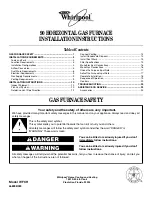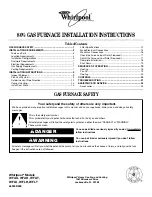
16
INSTALLATION CONSIDERATIONS
Furnace
Water
Heater
Opening
Chimney or Gas Vent
NOTE: The single opening must have
a free area of not less than one
square inch per 3000 BTU of
the total input rating of all equip-
ment in the enclosure, but not less than
the sum of the areas of all vent
connectors in the confined space.
Alternate
Opening
Location
Figure A.9.3.3.2 All Combustion Air
From Outdoors through Single Combustion Air Opening.
9.3.4 Combination Indoor and Outdoor Combustion Air.
The use of
a combination of indoor and outdoor combustion air shall be in accor-
dance with (1) through (3)
(see example calculation in Annex J]:
(1)
Indoor Openings:
Where used, openings connecting the interior
spaces shall comply with 9.3.2.3.
(2)
Outdoor Opening(s) Location.
Outdoor opening(s) shall be located
in accordance with 9.3.3.
(3)
Outdoor Opening(s) Size.
The outdoor opening(s) size shall be
calculated in accordance with the following:
(a)
The ratio of the interior spaces shall be the available volume
of all communicating spaces divided by the required volume.
(b) The outdoor size reduction factor shall be 1 minus the ratio of
interior spaces.
(c)
The minimum size of outdoor opening(s) shall be the full size
of outdoor opening(s) calculated in accordance with 9.3.3,
multiplied by the reduction factor. The minimum dimension
of air openings shall not be less than 3 in. (80 mm).
9.3.5 Engineered Installations.
Engineered combustion air installa-
tions shall provide an adequate supply of combustion, ventilation, and
dilution air and shall be approved by the authority having jurisdiction.
9.3.6 Mechanical Combustion Air Supply.
Where all combustion air
is provided by a mechanical air supply system, the combustion air shall
be supplied form outdoors at the minimum rate of 0.35 ft
3
/min per 1000
Btu/hr (0.034 m
3
/min per kW) for all appliances located within the
space.
9.3.6.1
Where exhaust fans are installed, additional air shall be provided
to replace the exhausted air.
9.3.6.2
Each of the appliances served shall be interlocked to the me-
chanical air supply system to prevent main burner operation where the
mechanical air supply system is not in operation.
9.3.6.3
Where combustion air is provided by the building’s mechanical
ventilation system, the system shall provide the specified combustion
air rate in addition to the required ventilation air.
9.3.7 Louvers, Grilles, and Screens.
9.3.7.1 Louvers and Grilles.
The required size of openings for com-
bustion, ventilation, and dilution air shall be based on the net free area of
each opening. Where the free area through a design of louver or grille or
screen is known, it shall be used in calculating the size opening required
to provide the free area specified. Where the louver and grille design and
free area are not known, it shall be assumed that wood louvers will have
25 percent free area, and metal louvers and grilles will have 75 percent
free area. Nonmotorized louvers and grilles shall be fixed in the open
position.
9.3.7.2 Minimum Scree Mesh Size.
Screens shall not be smaller than
1/4 in. mesh.
9.3.7.3 Motorized Louvers.
Motorized louvers shall be interlocked
with the appliance so they are proven in the full open position prior to
main burner ignition and during main burner operation. Means shall be
provided to prevent the main burner form igniting should the louver fail
to open during burner startup and to shut down the main burner if the
louvers close during burner operation.
9.3.8 Combustion Air Ducts.
Combustion air ducts shall comply with
9.3.8.1 through 9.3.8.8.
9.3.8.1
Ducts shall be constructed of galvanized steel or a material hav-
ing equivalent corrosion resistance, strength, and rigidity.
Exception: Within dwellings units, unobstructed stud and joist spaces
shall not be prohibited from conveying combustion air, provided that not
more than one fireblock is removed.
9.3.8.2
Ducts shall terminate in an unobstructed space, allowing free
movement of combustion air to the appliances.
9.3.8.3
Ducts shall serve a single space.
9.3.8.4
Ducts shall not serve both upper and lower combustion air
openings where both such openings are used. The separation between
ducts servicing upper and lower combustion air openings shall be main-
tained to the source of combustion air.
9.3.8.5
Ducts shall not be screened where terminating in an attic space.
9.3.8.6
Horizontal upper combustion air ducts shall not slope down-
ward toward the source of combustion air.
9.3.8.7
The remaining space surrounding a chimney liner, gas vent, spe-
cial gas vent, or plastic piping installed within a masonry, metal, or
factory built chimney shall not be used to supply combustion air.
Exception: Direct vent appliances designed for installation in a solid
fuel-burning fireplace where installed in accordance with the
manufacture’s installation instructions.
9.3.8.8
Combustion air intake openings located on the exterior of the
building shall have the lowest side of the combustion air intake openings
located at least 12 in. (300 mm) vertically from the adjoining grade level.
INSTALLATION POSITIONS:
DM96VE Models may only be installe up-flow or horizon-
tally with left or right side down. DC96VE models may be
installed down-flow or horizontally with left or right side down.
do not install any furnace on its back.
















































